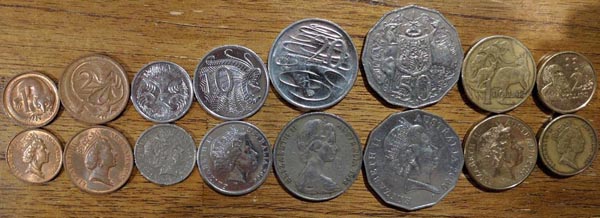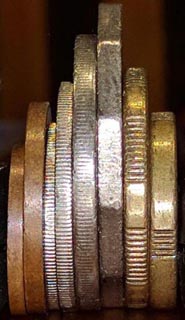

| HOME |
NEWSLETTER
| LIBRARY |
| Australian Decimal Coins Quentin Christensen, WINS#920 |
|
In 1901 the Commonwealth of Australia was formed, essentially gaining autonomy from England, although retaining the British monarchy as the head of state. In 1910, the relatively new Commonwealth of Australia issued the Australian pound, replacing the British pound as the official currency of the country. The new currency was based on the British pound, and initially fixed in value to the pound sterling. One pound consisted of 20 shillings, and each shilling was worth 12 pence. In February 1959, the government appointed a committee to investigate the suitability of moving to a decimal system of currency. While the idea was received quite favourably, the wheels of government turn slowly and indeed, it takes time to plan such a large change, and get the public used to the idea. The reason for the changeover was, of course, the easier mathematics involved in transactions in decimal currency, the same reason almost every other country also uses various forms of decimal currency. For the trivia, the two exceptions currently are Madagascar and Mauritania. Initially, the government of the day, led by (Sir) Robert Menzies, a monarchist, chose the name “royal” for the new currency, to be divided into 100 cents but retaining the names shilling, florin and crown for the 10, 20 and 50 cent pieces respectively. There was much public opposition to the name and so the name “dollar” ended up being used. A number of other names were proposed, among them, the austral, the oz, the boomer, the roo, the kanga, the emu, the digger, the quid, the dinkum and the ming (Menzies' nickname). |
 |
|
Changeover day was announced as the 14th February 1966, with both the Australian pound and dollar to be in use concurrently for around two years. A large awareness campaign with a catchy jingle was devised to explain the change. Several of the original videos are available on Youtube (search for “australian decimal currency ad” or similar). They provide a very interesting look not only at the reason for the changeover, but also a little of life of the day. I must say, as someone who has used decimal currency my whole life, I definitely find the mathematics of the pound, shilling and pence trickier. New Zealand, Australia’s nearest neighbour, followed suit with decimalisation of their own currency in 1967, also calling their new currency “dollar”. A quick search indicates around 20 different currencies called the dollar in use in over 55 countries and territories. The history and spread of the term could indeed be an interesting topic for an article in this journal (If I haven’t already missed such a piece). A gold and silversmith, Stuart Devlin won the competition to design the first Australian decimal coins. Over his career, he has designed coins and medals for 36 countries, including the medals for the founding awards of the Australian honours system in 1975. In 1982, Devlin was granted the Royal Warrant of appointment as goldsmith and jeweller to Her Majesty the Queen. The new Australia currency initially comprised 1, 2, 5, 10, 20 and 50 cent coins, as well as 1, 2, 5, 10 and 20 dollar notes. Coins began to be minted in 1964 for the new currency, at the Royal Australian Mint in Canberra, Melbourne and Perth. At various times, Australian decimal coins have also been struck by the Royal Mint. The totals produced for 1966 were:
For a total of 1,052,700,000 coins worth $50,470,000
|
|
All the coins were round, with the 1c and 2c coins having plain edges, and the other coins having milled edges. The 1966 50c piece was 31.64mm diameter and weighed 13.28 grams. It was comprised of 80% silver. As the price of silver rose, this became uneconomical. The mint never actually lost money producing the coin as all the silver was purchased before the metal value exceeded the face value. The other problem with the 50c piece was that, at 31.64mm diameter and 13.28 grams in weight, there was a lot of confusion with the 20c piece which was only slightly smaller at 28.65mm diameter and 11.3 grams in weight. The decision was taken to not only change the composition of the coin, but also to change the shape. No 50c pieces were minted for circulation in 1967 or 1968. In 1969, the new dodecagonal 50c coin entered circulation. The new 12 sided coin was still silver in appearance but now comprised 75% copper and 25% nickel, the same composition used in the 5, 10 and 20c coins. The 1 and 2c coins were copper in both appearance and composition (aside from 2.5% zinc and 0.5% tin). |
 |
|
In 1973 a $50 note was introduced and in 1984 a $100 note was also added. As early as the mid 1970’s it was recognised that Australia needed a higher value coin which could be practically used in coin operated machines. Such a coin would replace the one dollar note which had a short service life through high use. In 1984, the first $1 coins entered circulation. Comprised of 92% copper, 6% aluminium and 2% nickel, the coins are golden in appearance, and have a diameter of 25mm, in between the 10 and 20c pieces. With an interrupted milled edge (7 groups of 12 grooves) and a weight of 9 grams, the coins are readily distinguishable. The coins were followed in 1988 by the $2 coin, using the same composition, colour and again with an interrupted milled edge (four groups of 5 grooves). The $2 coin is smaller, at 20.5mm, it is only slightly larger than the 5c piece, though considerably thicker. In 1990, the Treasurer of the day announced that 1 and 2c coins would no longer be produced. In fact, the last 2c coins were minted in 1989. The reasons given were low purchasing power of the coins, and the rising cost of production. The coins were officially withdrawn from circulation from February 1992. Strict rules are still enforced regarding price rounding. If paying electronically, the exact price is charged. If paying by cash, the entirety of the purchase is rounded to the nearest 5c (a purchase of $5.92 is rounded to $5.90, a purchase of $5.93 is rounded to $5.95). Since not long after the successful removal of 1 and 2c pieces, debate has been ongoing about the future of the 5c piece. For now, it is still in production. The smallest coins of the country do have several notable distinctions. Being partly produced by the Royal mint in Llantrisant, Wales, the 2c coin of 1981 was the last circulating Australian coin struck outside the Royal Australian Mint. The final hurrah and public use of the 1 and 2c coins was that the withdrawn coins were melted down to make the bronze medals for the 2000 Summer Olympics, which were held in Sydney, Australia. The original coin designs all contained Australian native fauna: A feather tailed glider on the 1c, frill necked lizard on the 2c, echidna on the 5c, lyrebird on the 10c and a platypus in water on the 20c. The 50c piece has the Australian coat of arms: a kangaroo and an emu on left and right respectively, holding a shield containing the symbols of the six Australian states with the border of the shield representing federation in 1901. The $1 coin features 5 kangaroos, known as the “mob of roos”, designed, once again, by Stuart Devlin. Invitations for designs of the $2 coin were extended to a number of designers. The brief was to include a representation of the head and shoulders of a traditional Australian Aboriginal, the Southern Cross and Australian flora. The selected design was prepared by Mr Horst Hahne, with inspiration taken from a drawing by Mr Ainslie Roberts.
|